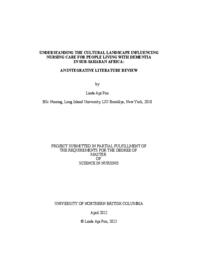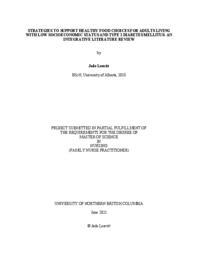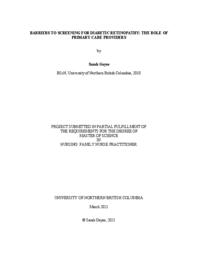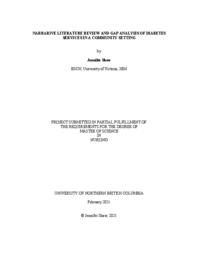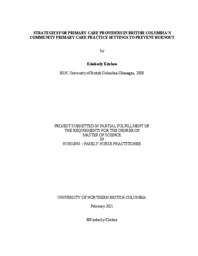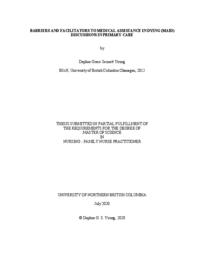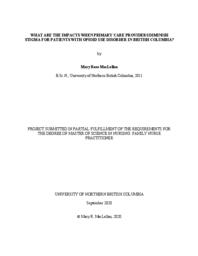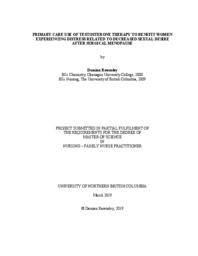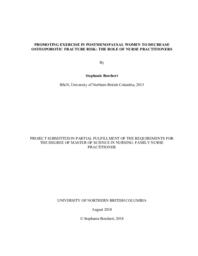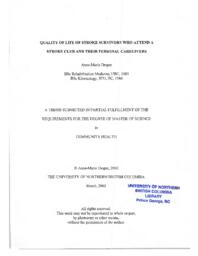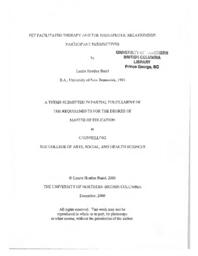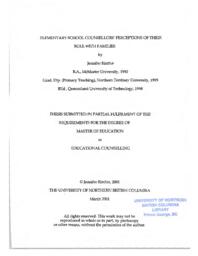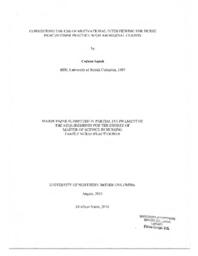Barton, Sylvia
Person Preferred Name
Sylvia Barton
Related Works
Content type
Digital Document
Origin Information
Content type
Digital Document
Description / Synopsis
With the rise, worldwide, in numbers of people rapidly surviving into older adulthood, the increasing prevalence of dementia has become a global public health priority of significance. The most alarming increase in dementia burden occurs in low and middle-income countries (LMIC), especially in Sub Saharan Africa (SSA). The purpose of this integrative review is to provide evidence-informed recommendations, based on the current literature that guides nurses practicing in SSA on how to safely care for people living with dementia. Cultural, social, and community perceptions, beliefs, and attitudes about dementia affect people living with dementia in profound ways. As such, culture-specific understandings need to be visible in the provision of quality nursing care across the diverse and complex landscape of urban and rural SSA. Whittemore and Knalf’s (2015) integrative literature review methodology and methods were used to conduct searches within CINAHL, PsycINFO, MEDLINE, and PubMed databases for relevant studies and systematic reviews by applying appropriate medical subject headings. Developed inclusion and exclusion criteria systematically guided the process of work through the literature search results. This process led to narrowing the focus of the body of literature and culminated in the selection of 17 peer-reviewed research articles of studies originating from seven SSA countries: Nigeria, South Africa (SA), Democratic Republic of the Congo (DRC), Uganda, Ghana, Kenya, and Tanzania. The set of articles were then each individually analyzed and collectively synthesized to answer the research question: How do cultural, social, and community perceptions, beliefs, and attitudes related to dementia affect people living with dementia and the quality of nursing care provided in Sub Saharan Africa? Four key themes emerged following the extraction of data from the articles: 1) nurses’ limited knowledge of how people live with dementia, especially with the cultural belief of dementia as witchcraft, 2) nurses’ misguided understanding of what help and health-seeking behaviors people experiencing dementia exhibit, 3) nurses’ lack of awareness of dementia-associated stigma and its influence on suffering and illness, and 4) nurses’ need for education related to the provision of nursing best practices when caring for people with dementia. The need for knowledge, understanding, awareness, and education for nurses caring for people living with dementia across Sub-Saharan African communities remains pertinent. There is also a need for these actions to extend deep into communities where traditional knowledge keepers, faith healers, and other healthcare professionals could be allies in supporting the pluralistic and collaborative provision of dementia care. Within SSA, nurses have the capacity to develop and implement low‐resourced nonpharmacological interventions to people living with dementia, and to partner with families in the achievement of patient-centered care. Nurses also have the capacity to provide leadership in orchestrating short and long-term initiatives that shift societal cultural and dementia understanding through practice, education, research, and policy recommendations.
Origin Information
Content type
Digital Document
Description / Synopsis
Type 2 diabetes mellitus (T2DM) is an increasing concern in Canada, with low socioeconomic status being a major risk factor. This review explores strategies to improve food access that promote healthy food choices among people experiencing food insecurity and living with T2DM. Whittemore and Knalf’s (2015) integrative literature review methodology was used to extract and analyse the evidence. Four key strategies emerged: 1) promoting healthy food affordability through incentives and disincentives, 2) understanding effective and ineffective food interventions, 3) enhancing nutritional education in the standard of care, and 4) manifesting empowerment through self-efficacy and diabetes management. These strategies can be applied by nurse practitioners within primary care. Aligned with a population health approach, they can direct practice, education, and research through healthy public policy focused on reducing the incidence of T2DM, particularly in people experiencing food insecurity.
Origin Information
Content type
Digital Document
Description / Synopsis
Heart failure is a chronic, progressive disease that remains on the rise partially due to improvements in preventing cardiac related mortality from other causes. Implanted cardioverter defibrillators are indicated for patients that are at high risk for sudden cardiac death from ventricular arrhythmias (primary prevention), or for those who have survived a cardiac death (secondary prevention). Guidelines suggest simple and easy to follow directions for providers to determine which patients would be eligible to be considered for a device. However, despite national guidelines, research supporting cost effectiveness, and a repeatedly demonstrated reduction in mortality with device therapy, referral and utilization of ICDs remain low, with most of the non-referral and underutilization rates identified within the primary care provider group. In addition, for those patients who do receive ICDs, advanced care planning with consideration of deactivation of the device at end-of-life is rarely completed, leaving many patients at risk of undignified and painful shocks delivered within the last hours to days of life. This integrative review seeks to explore: Primary care management of the heart failure patient requiring an implanted cardioverter defibrillator. A comprehensive search of the literature was undertaken and 15 articles were selected for inclusion This review establishes that ICDs are effective and relatively low-risk devices that have significant mortality benefits, and patients with HF should be screened routinely for eligibility for the device in order to help prevent SCD. Furthermore, patients who receive an ICD should complete an informed advance care directive which includes directions for management of the ICD at end-of-life. ICD management, while often deferred to specialists, requires a collaborative approach and consistent evaluation from the patient’s primary care provider, as it has the potential to influence all aspects of patient’s quality of life, as well as quality of end-of-life care. Recommendations for practice, education, further research, and policy have been made to support the role of primary care providers, such as Nurse Practitioners, in the management of HF patients requiring an ICD.
Origin Information
Content type
Digital Document
Description / Synopsis
Anxiety is a mental health condition affecting adolescents with negative side effects and consequences. Primary care providers are faced with a growing number of visits related to adolescent mental health and must be comfortable in assessing and treating the negative symptoms associated with anxiety. With the potential for anxiety to begin in adolescence and worsen in adulthood, a thorough search of the literature was completed to determine ways to help adolescents manage negative symptoms associated with anxiety and improve their coping skills. Mindfulness has been gaining popularity within the mental health community and therefore was chosen as the area of focus to determine how the implementation of mindfulness-based interventions in primary care could alleviate negative symptoms associated with adolescent anxiety. Upon completing the literature review, eight studies were chosen that highlighted how various care providers effectively delivered mindfulness interventions for adolescents experiencing anxiety, primarily within school and outpatient mental health settings. These studies showed trends related to positive effects including improving adolescent anxiety and improvements in other areas of the adolescents’ lives. Additionally, it was found that it was important for primary care providers to reinforce the importance of using a supportive approach including parents or caretakers as this was shown as a protective factor. Although there were no specific studies introducing mindfulness within adolescent primary care, a list of recommendations was developed to provide evidence-based rationale towards integrating mindfulness-based interventions within primary care. By doing so, this provides a foundation for mindfulness-based interventions that primary care providers can utilize to support adolescents in managing their negative symptoms associated with anxiety.
Origin Information
Content type
Digital Document
Description / Synopsis
Over the past fifteen years, primary care networks have been established across Canada; spaces whereby people can access a first point of contact with healthcare professionals focused on chronic disease management, health maintenance, and prevention. British Columbia has recently launched a model of primary care networks and interprofessional teams in response to a current health system challenged with demands related to an aging population and increased prevalence of chronic disease and disability. Using appreciative inquiry for understanding organizational social system change, information was gathered to explore the strengths and directional change needed as shared by primary care providers and case managers working in a Vancouver Island health authority primary care network. The purpose of the project was to understand how these providers could work more effectively within integrated interprofessional teams. Actions focused on the process of facilitating connection, communication, relationship, collaboration and autonomy within these networks are explicated.
Origin Information
Content type
Digital Document
Description / Synopsis
Transitions to long-term care are significant and often challenging experiences for older adults with dementia and their caregivers, with waiting lists a common occurrence due to an aging population and a limited supply of long-term care beds. To better understand the complexities related to transitions to long-term care and inform clinical practice, a comprehensive project was undertaken and included an integrative literature review and a gap analysis of local practices in the interior of British Columbia. The literature review and gap analysis findings were analyzed and presented thematically through interrelated themes, including key concepts surrounding the phases of a transition, caregiver coping, and professional support. Four key recommendations arose from this project regarding continuity and coordination of care, discharge planning, post-discharge care, and evaluation. The strengths, limitations, and implications of this project are discussed, including next steps to mobilize knowledge related to the recommendations and influence evidence-informed changes in practice.
Origin Information
Content type
Digital Document
Description / Synopsis
Diabetes is a serious health concern that affects millions of people world-wide. The comorbidities and complications of diabetes are complex and require awareness within the healthcare system. Diabetic retinopathy affects a significant number of patients living with diabetes. Early detection through screening is recognized as the standard of care, in order to assess and monitor for diabetic retinopathy progression. Unfortunately, screening services are not always accessed, especially within the suggested time frames and frequencies. Currently there is limited data regarding the barriers that exist for individuals to access these crucial screening services. An integrative literature review approach was conducted to answer the research question: What strategies can nurse practitioners in the primary care setting use to promote screening for people living with diabetes to reduce their risk and progression to blindness from diabetic retinopathy? Four themes emerged from the findings which provided insight into determinants that affect diabetic retinopathy screening adherence: structural barriers to care, socioeconomic conditions, emotional barriers to accessing healthcare, and knowledge deficits. Discussion of three recommendations for primary care practice focus on: reassessing screening methods and intervals, activity sharing, and providing education. Implications for future research to enhance patient care are outlined.
Origin Information
Content type
Digital Document
Description / Synopsis
Pediatric patients in northern BC have some of the highest asthma prevalence rates compared to children in other areas of the province. Adequate parental health literacy skills are particularly important to make informed health management choices when caring for children with asthma. In this project, a gap analysis process was followed, and three evidence-informed practice gaps related to pediatric asthma care were identified. Findings highlight the need for increased asthma education and parental health literacy resources to address concerns mentioned during stakeholder engagement. Four key recommendations were formulated regarding parental health literacy assessments, clear language requirements for written asthma materials, access to specialized care resources, and adaptation of current asthma education models. In conclusion, the development of a working group that includes asthma and health literacy stakeholders, is the next step to address the findings of this project and improve the overall asthma health outcomes for children in northern BC.
Origin Information
Content type
Digital Document
Description / Synopsis
The goal of this project was to outline best practices regarding the organization of diabetes care and services in the community in relation to the local context of services in Squamish, BC, Canada to create a foundation for future quality improvement work. The theoretical framework of personcentered care is essential to chronic disease management and underpins this work. The methods include: 1) A narrative literature review consisting of a database search, and 2) A gap analysis consisting of local data and an environmental scan. The Chronic Care Model is an evidence-based integrated care framework used to organize the findings of the narrative literature review and the gap analysis and to frame the recommendations (Clement et al., 2018). Based on the findings, evidence-based recommendations were created specific to the context of diabetes care in Squamish, BC creating the opportunity for meaningful future quality improvement work.
Origin Information
Content type
Digital Document
Description / Synopsis
Primary care providers (PCPs) suffer from high rates of burnout. Burnout is the result of chronic workplace stress. Burnout can significantly impact the PCP’s personal and professional life and can lead to devastating consequences. Literature often addresses organization level strategies to improve burnout rates but there is a dearth of literature focusing specifically on PCP-directed strategies to prevent burnout. Using Whittemore and Knafl’s (2005) method for integrative literature reviews, ten articles were reviewed. Results suggest that PCPs can reduce burnout by building a strong professional community. Additionally, the results suggest that burnout may be prevented by strengthening one’s personal resources via positive emotions. Recommendations for building a strong professional community and strengthening the PCP’s personal resources are discussed and specific strategies PCPs can implement are presented.
Origin Information
Content type
Digital Document
Description / Synopsis
This integrative literature review strives to determine if the delivery of reproductive and sexual health services provided through high school-based primary care clinics can improve BC adolescent sexual and reproductive health. Adolescent sexual and reproductive health not only impacts life-long health; it also has significant societal implications. Although BC has begun to focus on adolescent health, innovative health service solutions are needed to improve adolescents’ health. Systematic search through the University of Northern British Columbia online library databases and Google scholar and the evaluation of the literature using CASP analysis tools resulted in the inclusion of 10 articles. Findings suggest school-based health clinics (SBHCs) decrease barriers that adolescents experience when accessing health services as well as public health system costs. Moreover, SBHCs are an effective mechanism to support adolescent reproductive and sexual health needs, especially in those populations with elevated levels of sexual and reproductive risk factors. However, for SBHCs to be effective, sustainable funding needs to be sourced, and barriers adolescents experience when accessing services need to be evaluated and addressed. SBHCs can complement current adolescent-friendly services to meet this unique population’s needs; however, further research is needed. More robust research on various demographics, health outcomes, and Canadian-based examination is required to strengthen SBHC implementation recommendations.
Origin Information
Content type
Digital Document
Description / Synopsis
In Canada, medical assistance in dying (MAiD) is an end of life intervention intended to offer increased control to Canadians within the dying process (Brassfield & Buchbinder, 2020). Despite the legalization of MAiD in 2016 and developments in MAiD research, many primary care providers (PCPs) reported feeling reluctant to discuss MAiD with their patients (Otte, Jung, Elger, & Bally, 2017). In Canada, PCPs are typically medical doctors (MDs) or nurse practitioners (NPs) who care for patients in outpatient, non-acute care settings (Statistics Canada, 2019). As limited research has been synthesized on barriers and facilitators of MAiD discussions within the Canadian primary care context, the purpose of this integrative literature review (ILR) was to assess what factors promoted and prevented PCPs from discussing MAiD with their patients. After identifying a research question and related keywords, six databases were searched to identify relevant studies. The initial search yielded 1,874 results, which underwent inclusion and exclusion criteria and resulted in 12 references being included in the review. After collating the data, evaluating it, and summarizing the results, facilitators and barriers that affected the discussion of MAiD between PCPs and patients were divided into intrinsic and interpersonal factors. Intrinsic factors included PCP emotions, values, beliefs, education, and training, while interpersonal factors included communication, relationship, and administrative burdens (Brooks, 2019; Brassfield & Buchbinder, 2020; Selby & Bean, 2019; Kelly & Varghese, 2006; Pasman, Willems, & Onwuteaka-Philipsen, 2013; Hagens, Onwuteaka-Philipsen, & Pasman, 2017). Based on the findings of this review, strategies to promote MAiD discussions between PCPs and patients were outlined. Recommendations included identifying and addressing values, beliefs, and emotions; developing communication skills and strategies; promoting patientii provider relationships; and mitigating administrative burdens (Kelly & Varghese, 2006; Selby & Bean, 2019; Pasman et al., 2013; Brooks, 2019). As MAiD-related research in Canada progresses through its pioneering phase, future research has been suggested to support the development of communication guides specific to MAiD as well as the evaluation of PCP approaches to MAiD discussions within the Canadian primary care setting (Selby & Bean, 2019; Brooks, 2019).
Origin Information
Content type
Digital Document
Description / Synopsis
Stigma is a complex phenomenon with a myriad of detrimental health and social impacts that are not fully studied or understood. Persistent stigma exists towards individuals who have opioid use disorder (OUD) in British Columbia. OUD is a chronic, relapsing, clinical condition that has been identified as one of the most challenging substance use disorders. For those affected, they must also endure the consequences of stigma that promote barriers to health care, health and social inequalities, diminished quality of life as well as increased morbidity and mortality. The current unremitting opioid overdose crisis in British Columbia further emphasizes the importance of eradicating stigma towards individuals who use opioids and/or suffer from OUD, as untreated OUD is fueling this multifaceted public health emergency. For these reasons, an integrative literature review has been conducted to identify how primary care providers in British Columbia can address the intersecting stigmas for individuals suffering OUD. The results are discussed within the context of primary health care in British Columbia. Whittemore and Knafl’s approach to the integrative literature review was utilized in this study to review eleven pertinent articles. The findings suggest that stigma occurs on varying levels for individuals with OUD that serve to reinforce each other and manifest as discrimination, mistrust, social distancing, minimized advocacy, unequal access to health care and suboptimal health care. Further, the findings indicated that the role of primary care providers may be instrumental in eradicating stigma in a timely manner. Recommendations for primary care providers to dismantle the stigma associated with OUD are discussed, and specific strategies for the primary care setting are presented.
Origin Information
Content type
Digital Document
Description / Synopsis
Type 2 Diabetes (DM 2) is increasingly prevalent worldwide. Its potential for debilitating long-term sequelae and subsequent burden on healthcare systems highlight the importance of adequate diabetes management. Glucose control remains central to treatment and often includes nutritional therapy, pharmacotherapy and self-management strategies. Individuals with DM 2 who experience food insecurity (FI) are at an increased risk of poorly managed diabetes. Nurse practitioners in primary care are specifically skilled at identifying patient difficulties in making, adopting and adhering to lifestyle changes, thus are ideally positioned to address barriers to chronic disease management. However, it remains unclear how FI influences DM 2 and how it is accurately identified in the primary care setting. An integrative literature review was completed to identify which strategies nurse practitioners can employ in primary care to identify and thus enhance the management of DM 2 among patients experiencing FI.
Origin Information
Content type
Digital Document
Origin Information
Content type
Digital Document
Origin Information
Content type
Digital Document
Origin Information
Content type
Digital Document
Origin Information
Content type
Digital Document
Origin Information
Content type
Digital Document
Origin Information
Content type
Digital Document
Origin Information
Content type
Digital Document
Origin Information
Content type
Digital Document
Origin Information
Content type
Digital Document
Origin Information


